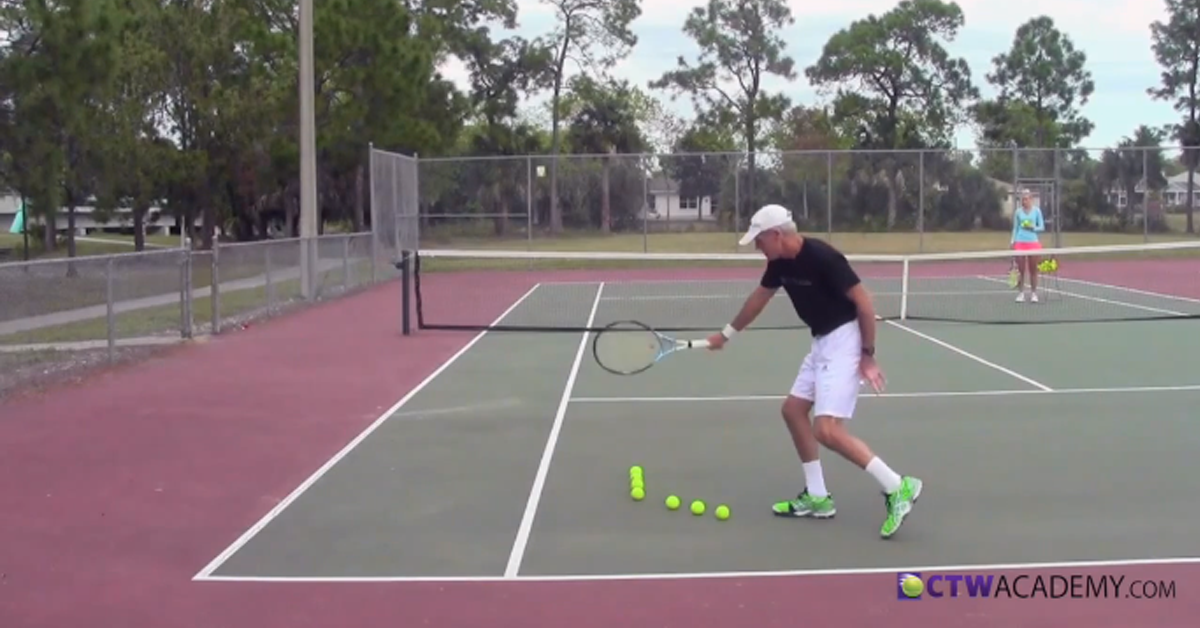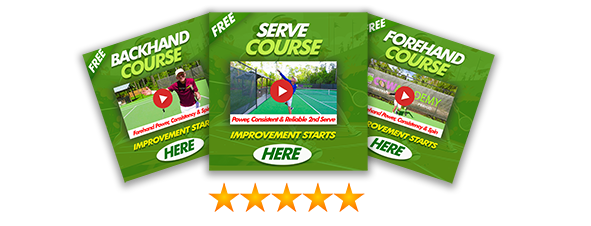VIDEO INFO:
One of the CTW Academy members asked, “I often have to struggle with a curious problem: when I play the left side of the court I use to hit very easily fast and deep cross-court backhands, but it’s always very hard to me addressing the ball down the line. I suspect this involves my stance and feet position, but I still haven’t found a way to fix it.”
Being able to hit down the line from both sides is a very valuable tool. It enables you to change direction against baseliners and to pass net rushing opponents. However, to really get a feel for and to own this shot, you’ll need to learn the fundamentals of an inside-out swing.
I have a video at the CTW Academy that will help you with this valuable shot.



Hi Tom Avery,
I studied your sample lessons concerning the forehand . Your foot position seems to put the weight on the left foot from the very beginning of the movement whereas other coaches start from the right foot in open position and then shift the weight onto the left foot.
Is that correct ?
Kind regards
Juergen
Hi Juergen,
I’m not sure exactly what you’re saying because I agree the rear foot and for me (being right-handed) it’s the right foot is set FIRST whether I’m hitting an open stance forehand or a closed stance when I step into the shot with the left foot. Shifting the weight to the left foot is correct.
All the best,
Tom
great coaching
thanks
You’re welcome!!
Tom
I notice that you hit the forehand with your wrist bent back at impact with ball. I’m having difficulty doing this. My wrist, hand and arm are in a straight line. Is this good or bad. If bad, what must I do to correct this?
Patrick,
The wrist bent back at contact is personal preference, players that use ‘elbow flexion’ technique on the forehand have more wrist bent back, players with ‘elbow extension’ have very little if any. So what you’re doing is OK as long as you are getting the desired result… meaning your forehand is consistent and powerful.
All the best,
Tom
Hey Tom,
So Ive been having trouble with foot positioning. I will hit balls too far or into the net because of this. Can you make a video to help me out?
Luc,
Usually shots into the net is related to not bending enough and getting your racquet low enough before swinging forward… remember from the baseline the ball should be ascending off your strings. Shots that are going too far are usually caused by an open racquet face at contact, make sure the racquet face is closed or facing down at the low point of the backswing before swinging forward. This is explained in the “Rock Solid Forehand” course.
All the best,
Tom
YOU’RE A GREAT COACH! And you certainly have your own technique together. My own philosophy has been to learn from the best in the world when trying to learn anything. As a guitar player I learned to play like Santana and Hendrix by listening and copying their playing and techniques. I’m 71 years old now. In tennis I always copied Pete Sampras. I video taped him and watched in slow motion. I think you will agree that he had the best down the line back-hand around in his championship days, as well as the best forehand down-the-line! I can’t count how many down-the-line winners he made! A young player known as Roger Federer also copied Sampras even playing with the same racquet, Wilson’s ProStaff, a 12.6 oz heavy racquet. Pete made it even heavier with lead tape! Players called it “The Log!” Heavy racquets allow much better shot making than light ones. I know you know this because your own racquets are designed with that knowledge in mind. Roger now copied the same weight; slightly higher head-light at 9 points vs 7 points; in a larger face racquet (97″ vs 85″) to help eliminate his mishits, and is back on top where he belongs! As far as backhand shots down-the-line go: watch Sampras. I see him following through straight up parallel to the line, thereby guiding the ball in a straight path down-the- line! I believe that the follow through is the most important aspect of a shot, that determines where the ball goes! If you watch Pete’s incredible serve, you also see him following through in the direction of the ball path! That’s why his racquet is always in his belly! For me, this explains his incredible ace percentage, especially to the “T”! To this day, his percentage is the highest in Tennis history, and includes the best second serve ace statistics as well. Only with a reliable direction could he achieve the results he did. For me, that is defined as the path of his follow through from before to after contact point! Thinking reasonably, trying to meet the ball at precisely the right moment during an arc swing to time the right facing of the racquet to direct the ball path; is much more difficult, and has a much higher percentage of error. It’s therefor less reliable, than a swing that has a path in the direction of the shot! My simple credo: Follow through in the direction of your shot to improve your aim, no matter what shot it is!
Of course, there always exceptions to the rule. Spin shots that make the ball bounce toward or away from the opponent come to mind. The grip used is also important. Both Sampras and Fed use an Eastern grip. This grip is very conducive to hitting straight.
Another addendum, heheh! The Eastern backhand and continental grips are also conducive to straight backhands, if you follow through in the direction in which you are aiming!
Valid points Joel.
Thank you,
Tom
Thanks for sharing Joel.
Tom
I saw Santana live at their first East Coast appearance in Atlantic City in 1969, never forget it. Thanks Joel for the compliment.
All the best,
Tom
Dear Tom,
“How do my feets always find the right spot” for doing the forehand and backhand hitting /movement okay.
Please can you sent me some more information about positioning, in combination with timing and focus on the ball.
Best regards
Dick
Hi Dick,
Try to see the ball as it’s coming off your opponents racquet. Keep your eyes focused on the ball and when the ball bounces on your side say the word ‘Bounce’ in your mind or out loud in an undertone. Then say ‘Hit’ when the ball contacts your racquet. So it’s “Bounce – Hit” either in your mind or try it out loud in practice, this will help. Also, do not get too close to the ball which cramps your swing, I’d rather see you too far away than too close.
All the best,
Tom
great slow motion video
Thanks!!
Tom